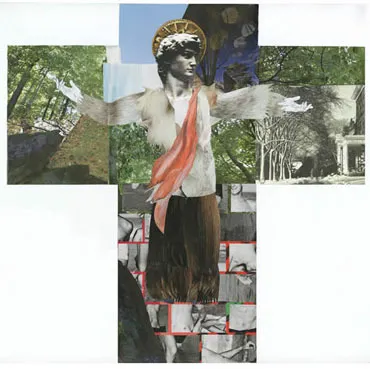Student Projects - Dostoevsky

Rachel Lee
RUSS 21
Johnson
5-13-10
Analysis of Interpretive Project
I had originally planned to create both Rogozhin's and Myshkin's crosses in the style of Russian icons, but decided to make one large cross instead. This large cross would better illustrate the ways in which Myshkin and Rogozhin combine to form the original ‘perfectly beautiful human being' that Dostoevsky envisioned.
The cross is divided horizontally and vertically, into what could be called Rogozhin and Myshkin territories. The lower half of the cross displays the brickwork of black-and-white bodies with green and red ‘mortars' visible through the cracks. The fragmentation of bodies ties back to Dostoevsky's descriptions of Nastasya. The orderliness of the brickwork pattern refers to Rogozhin's ability to scheme and calculate. Beneath this orderly façade, lies the suggestion of an unquenchable, fiery passion, his physical desire for Nastasya. The small amount of green visible between the bricks alludes to another of Rogozhin's greed, his desire to possess everything he wants.
The upper half of the cross, Myshkin territory, represents the spiritual half of the Dostoevsky's original idea. In this portion of the cross, there is a noticeable lack of artifice and of people. Myshkin cares deeply for the suffering of others. The emotional connections he establishes with those around him, along with the inexplicable attraction that others feel toward him, cast Myshkin as more of a spiritual than a secular being. Movement up the cross shows the transition from the passionate Rogozhin half of the cross, to nature scenes and then finally to the images of the sky that crowd around Christ's head. These images of heaven appear to rest on Christ's shoulders and concentrate around his halo.
This curious portrayal of Christ merits explanation. His head is the head of Michelangelo's David, reportedly the most beautiful man ever to have lived. The positioning of his hands is not the customary placement. They express longing, not suffering, and seem to beckon to something the spectator is unable to see. The richness of Christ's garments connect him to Rogozhin, while his slight build alludes to Myshkin's body, which at first sight indicates that he suffers from falling sickness. The small red toga lying across Christ's chest again refers to Rogozhin's passionate nature. What appears to be a skirt is intended to be the lower half of a robe, much like the robes the figures in religious icons wear. This robe is constructed from human hair, making it all the more expensive and bizarre.
Finally, the stones at the two left bottom corners serve as counterpoints to the direction in which Christ is looking. They demonstrate the opposition between the weight of sin and lightness of God's good graces. Christ looks away from the stones, which resonates with the novel's conclusion. Prince Christ could not endure the world. Thus the world will have lost its savior.



